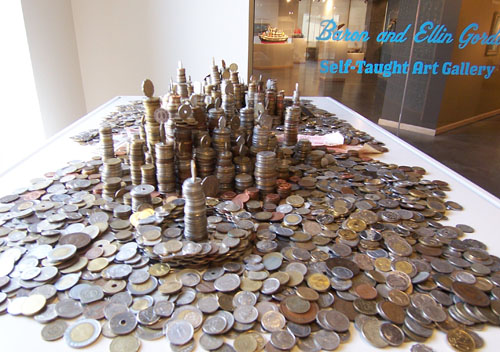Here are my two favorite money games. Change for the Better is based on a James Ernest design. He's the genius behind Cheapass Games (don't be put off by the name), and the game this is based on, Fight, he used to have on his business card. It really has some non-trivial strategy and thinking to it. Later I made the connection - or one of my preservice teachers did - with Smart, the excellent poem by Shel Silverstein. The other game I think I invented, Make It Take It. The idea was from a group of teachers who wanted students to be forced to find non-standard combinations of coins, instead of always taking 27 pennies, for example. That suggested a dwindling resource game to me. It's poissible to combine both with some visual representations of money, which is a nice support for struggling students. The handout is here, if you like worksheets or some of the representation support.
Smart
by Shel Silverstein
My dad gave me one dollar bill
'Cause I'm his smartest son,
And I swapped it for two shiny quarters
'Cause two is more than one!
And then I took the quarters
And traded them to Lou
For three dimes -- I guess he don't know
That three is more than two!
Just then, along came old blind Bates
And just 'cause he can't see
He gave me four nickels for my three dimes,
And four is more than three!
And I took the nickels to Hiram Coombs
Down at the seed-feed store,
And the fool gave me five pennies for them,
And five is more than four!
And then I went and showed my dad,
And he got red in the cheeks
And closed his eyes and shook his head--
Too proud of me to speak!
Change for the Better
Materials: Each player needs 1 quarter, 2 dimes, 3 nickels, and 4 pennies.
Rules: Play in groups of 2 to 6. Each player takes a turn. On their turn they put in one coin. They can take out a combination of coins that is less than the value of what they put in. For example, if you put in a dime (10¢) you can take back up to 9¢ – if it is there. Play continues until only one person has money left.
Instruction: Beginning players should just concentrate on the moves of the game. After students have gained some experience with the game, they can try recording their games to translate to symbolic representation. The data collected can then be examined for patterns.
Make It, Take It
a money game for 2 players or teams
Materials: Play coins or coin pictures or cards, amount cards. Record sheet if desired.
Play: Put the coins in the center. Shuffle the amount cards and make a stack. Players each turn over an amount card, and the player with the smaller amount goes first. On subsequent turns, players turn over an amount card, and see if they can make that amount with the coins. If they can, they take the coins. If they can not, it’s the other player’s turn. Play until all coins are gone, or both players in a row can’t make their amounts. The winner is the player with the biggest total value of coins they collected.
Variations:
Recommended starting amounts – 4 quarters, 6 dimes, 8 nickels, 10 pennies. Other amounts can be used. Teachers can add amount cards for more complicated amounts.
Players can roll two dice to determine the amount. (Note the dice variation requires more pennies.) Advanced play allows people to make change with the coins they’ve collected. For example, trading a dime from the center with two nickels they have taken before.
Players can use dollar value charts to keep a running total.
Example:
Bill and Keenya have been playing for a few turns.
Bill turns over 12 cents and takes two nickels and two pennies.
Keenya turns over 25 cents, but there are no quarters left. She takes five nickels.
Bill turns over 50 cents and can not make it.
Keenya turns over 6 cents and takes a nickel and a penny.
Bill turns over …
Instruction:
As with most games, it is recommended to play a game with teacher vs. the whole class to launch the game. Emphasize the variation in ways to make an amount by soliciting other possibilities from the students. Ask questions like “what card would be good to turn over next?” or “what card would leave me with no possibilities?” If someone is stuck, encourage good sportsmanship in helping them figure out a way to make the total. If that doesn’t seem to be working, or you are worried about their ability to make the amounts, students can play in a team of two vs. another team of two.
Many students will try a place value approach first, taking dimes and pennies. This will rapidly run them out of one or the other, forcing them to find other amounts. The amount cards concentrate on values that can be made with one, two or three coins, though several can be made with many more coins.
In summary, the teacher may wish to have students share their strategy for figuring their total at the end of the game. It is important to summarize by having students describe how they knew if they could make an amount or not. Another interesting discussion to start is if there is a strategy for better ways to play the game – is there an advantage to using fewer or more coins to make your moves?

Thanks for not only sharing your games but also for sharing the nice PDF. This is something we'll surely do later when the money topic comes around again.
ReplyDelete